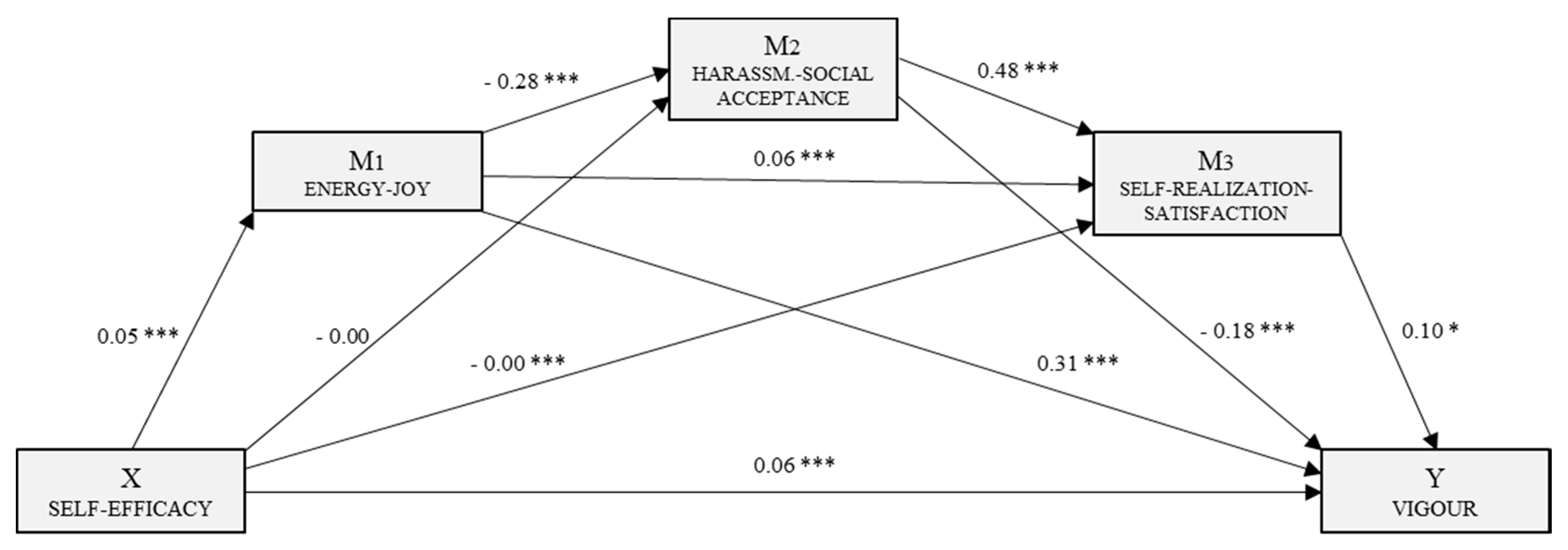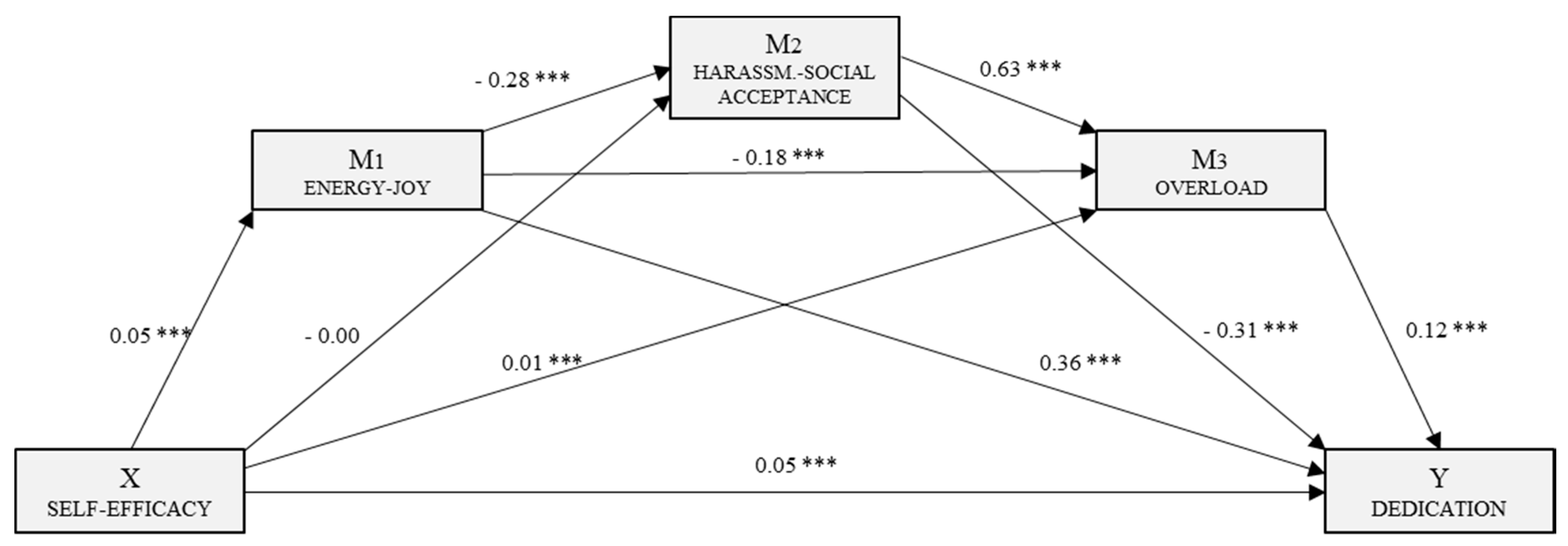The Mediating Role of Perceived Stress in the Relationship of Self-Efficacy and Work Engagement in Nurses
Abstract
1. Introduction
2. Materials and Methods
2.1. Participants
2.2. Instruments
2.3. Procedure
2.4. Data Analysis
3. Results
3.1. Self-Efficacy, Perceived Stress and Engagement
3.2. Self-Efficacy and Components of Perceived Stress as Predictors of Engagement in Nurses
3.3. Mediation Models for the Estimation of Predictors and Routes of Mediation Effects for Engagement Dimensions
4. Discussion
5. Conclusions
Author Contributions
Funding
Acknowledgments
Conflicts of Interest
References
- Salanova, M.; Martínez, I.M.; Llorens, S. A more “positive” look at occupational health from positive organizational psychology during crisis times: Contributions from the WoNT research team. Papeles del Psicólogo 2014, 35, 22–30. [Google Scholar]
- Salanova, M.; Schaufeli, W. El engagement en el trabajo. Cuando el trabajo se convierte en pasión; Alianza Editorial: Madrid, Spain, 2009; ISBN 978-84-206-6854-3. [Google Scholar]
- Maslach, C.; Schaufeli, W.B.; Leiter, M.P. Job burnout. Annu. Rev. Psychol. 2001, 52, 397–422. [Google Scholar] [CrossRef] [PubMed]
- Otero-López, J.M.; Villardefrancos, E.; Castro, C.; Santiago, M.J. Stress, positive personal variables and burnout: A path analytic approach. Eur. J. Educ. Psychol. 2014, 7, 95–106. [Google Scholar] [CrossRef]
- Rodríguez-Fernández, A.; Ramos-Díaz, E.; Fernández-Zabala, A.; Goñi, E.; Esnaola, I.; Goñi, A. Contextual and psychological variables in a descriptive model of subjective well-being and school engagement. Int. J. Clin. Health Psychol. 2016, 16, 166–174. [Google Scholar] [CrossRef] [PubMed]
- Schaufeli, W.B.; Salanova, M.; González-Romá, V.; Bakker, A.B. The measurement of engagement and burnout: A two sample confirmatory factor analytic approach. J. Happiness Stud. 2002, 3, 71–92. [Google Scholar] [CrossRef]
- Schaufeli, W.B.; Bakker, A. UWES, Utrecht Work Engagement Scale; Utrecht University: Utrecht, The Netherlands, 2003. [Google Scholar]
- Shimazu, A.; Schaufeli, W.B.; Kamiyama, K.; Kawakami, N. Workaholism vs. work engagement: The two different predictors of future well-being and performance. Int. J. Behav. Med. 2015, 22, 18–23. [Google Scholar] [CrossRef]
- Rodríguez-Muñoz, A.; Sanz-Vergel, A.I.; Demerouti, E.; Bakker, A.B. Engaged at work and happy at home: A spillover-crossover model. J. Happiness Stud. 2014, 15, 271–283. [Google Scholar] [CrossRef]
- Hakanen, J.J.; Schaufeli, W.B. Do burnout and work engagement predict depressive symptoms and life satisfaction? A three-wave seven-year prospective study. J. Affect Disord. 2012, 141, 415–424. [Google Scholar] [CrossRef]
- Lisbona, A.; Palaci, F.; Salanova, M.; Frese, M. The effects of work engagement and self-efficacy on personal initiative and performance. Psicothema 2018, 30, 89–96. [Google Scholar] [CrossRef]
- Bakker, A.B.; Demerouti, E.; Lieke, L. Work engagement, performance and active learning: The role of conscientiousness. J. Vocat. Behav. 2012, 80, 555–564. [Google Scholar] [CrossRef]
- Bakker, A.B. Job crafting among health care professionals: The role of work engagement. J. Nurs. Manag. 2017, 26, 321–331. [Google Scholar] [CrossRef] [PubMed]
- Salanova, M.; Agut, S.; Peiró, J.M. Linking organizational resources and work engagement to employee performance and customer loyalty: The mediation of service climate. J. Appl. Psychol. 2005, 90, 1217–1227. [Google Scholar] [CrossRef] [PubMed]
- Gracia, E.; Salanova, M.; Grau, R.; Cifre, E. How to enhance service quality through organizational facilitators, collective work engagement and relational service competence. Eur. J. Work Organ. Psy. 2012, 22, 42–55. [Google Scholar] [CrossRef]
- Torrente, P.; Salanova, M.; Llorens, S.; Schaufeli, W.B. Teams make it work: How team work engagement mediates between social resources and performance in teams. Psicothema 2012, 24, 106–112. [Google Scholar] [PubMed]
- Xanthopoulou, D.; Bakker, A.B.; Demerouti, E.; Schaufeli, W.B. Work engagement and financial returns: A diary study on the role of job and personal resources. J. Occup. Organ. Psychol. 2009, 82, 183–200. [Google Scholar] [CrossRef]
- Demerouti, E.; Bakker, A.B.; Nachreiner, F.; Schaufeli, W.B. The job demands resources model of burnout. J. Appl. Psychol. 2001, 86, 499–512. [Google Scholar] [CrossRef] [PubMed]
- Bakker, A.B.; Demerouti, E. Job demands-resources theory: Taking stock and looking forward. J. Occup. Health Psychol. 2017, 22, 273–285. [Google Scholar] [CrossRef]
- Bakker, A.B.; Demerouti, E.; Sanz-Vergel, A.I. Burnout and work engagement: The JD-R approach. Annu. Rev. Organ. Psychol. Organ. Behav. 2014, 1, 389–411. [Google Scholar] [CrossRef]
- Vizoso-Gómez, C. M.; Arias-Gundín, O. Resiliencia, optimismo y burnout académico en estudiantes universitarios. Eur. J. Educ. Psychol. 2018, 11, 47–59. [Google Scholar] [CrossRef]
- Salanova, M.; Llorens, S.; Martínez, I.M. Contributions from positive organizational psychology to develop healthy and resilient organizations. Papeles del Psicólogo 2016, 37, 177–184. [Google Scholar]
- Xanthopoulou, D.; Bakker, A.B.; Demerouti, E.; Schaufeli, W.B. The role of personal resources in the job demands-resources model. Int. J. Stress Manag. 2007, 14, 121–141. [Google Scholar] [CrossRef]
- Bandura, A. Self Efficacy: The Exercise of Control; Freeman: New York, NY, USA, 1997. [Google Scholar]
- Gázquez, J.J; Pérez-Fuentes, M.C.; Ruiz, M.I.; Miras, F.; Vicente, F. Estrategias de aprendizaje en estudiantes de enseñanza secundaria obligatoria y su relación con la autoestima. Int. J. Psych. Psychol. Ther. 2006, 6, 51–62. [Google Scholar]
- Salanova, M.; Bresó, E.; Schaufeli, W.B. Hacia un modelo espiral de las creencias de eficacia en el estudio del burnout y del engagement. Ansiedad y Estrés 2005, 11, 215–231. [Google Scholar]
- Van Wingerden, J.; Derks, D.; Bakker, A.B. The impact of personal resources and job crafting interventions on work engagement and performance. Hum. Res. Manag. 2017, 56, 51–67. [Google Scholar] [CrossRef]
- Wersebe, H.; Lieb, R.; Meyer, A.H.; Hofer, P.; Gloster, A.T. The link between stress, well-being and psychological flexibility during an Acceptance and Commitment Therapy self-help intervention. Int. J. Clin. Health. Psychol. 2017, 18, 60–68. [Google Scholar] [CrossRef]
- Lorente, L.; Salanova, M.; Martínez, I.M.; Vera, M. How personal resources predict work engagement and self-rated performance among construction workers: A social cognitive perspective. Int. J. Psychol. 2014, 49, 200–207. [Google Scholar] [CrossRef]
- Grau, R.; Salanova, M.; Peiró, J.M. Efectos moduladores de la autoeficacia en el estrés laboral. Apuntes. Psicol. 2012, 30, 311–321. [Google Scholar]
- Molero, M.M.; Pérez-Fuentes, M.C.; Gázquez, J.J.; Simón, M.M.; Martos, A. Burnout risk and protection factors in certified nursing aides. Int. J. Environ. Res. Public Health 2018, 15, 1116. [Google Scholar] [CrossRef]
- Ventura, M.; Salanova, M.; Llorens, S. Professional self-efficacy as a predictor of burnout and engagement: The role of challenge and hindrance demands. J. Psychol. 2015, 149, 277–302. [Google Scholar] [CrossRef]
- Sanz-Carrillo, C.; García-Campayo, J.; Rubio, A.; Santed, M.A.; Montoro, M. Validation of the Spanish version of the perceived stress questionnaire. J. Psychosom. Res. 2002, 52, 167–172. [Google Scholar] [CrossRef]
- Martos, A.; Pérez-Fuentes, M.C.; Molero, M.M.; Gázquez, J.J.; Simón, M.M.; Barragán, A.B. Burnout y engagement en estudiantes de Ciencias de la Salud. Eur. J. Investig. Health Psychol. Educ. 2018, 8, 23–36. [Google Scholar] [CrossRef]
- Hunsaker, S.; Chen, H.C.; Maughan, D.; Heaston, S. Factors that influence the development of compassion fatigue, burnout and compassion satisfaction in emergency department nurses. J. Nurs. Scholarsh. 2015, 47, 186–194. [Google Scholar] [CrossRef] [PubMed]
- Levenstein, S.; Prantera, V.; Varvo, V.; Scribano, M.L.; Berto, E.; Luzi, C.; Andreoli, A. Development of the perceived stress questionnaire: A new tool for psychosomatic research. J. Psychosom. Res. 1993, 37, 19–32. [Google Scholar] [CrossRef]
- Baessler, J.; Schwarcer, R. Evaluación de la autoeficacia: Adaptación española de la escala de Autoeficacia General. Ansiedad y Estrés 1996, 2, 1–8. [Google Scholar]
- Sanjuán, P.; Pérez, A.M.; Bermúdez, J. Escala de autoeficacia general: Datos psicométricos de la adaptación para población española. Psicothema 2000, 12, 509–513. [Google Scholar]
- Elm, E.; Altman, D.G.; Eggera, M.; Pocockd, S.J.; Gotzsche, P.C.; Vandenbroucke, J.P. Declaration of the STROBE Initiative (Strengthening the Reports of Observational Studies in Epidemiology): Guidelines for the communication of observational studies. Gac. Sanit. 2008, 22, 144–150. [Google Scholar] [CrossRef]
- Preacher, K.J.; Hayes, A.F. SPSS and SAS procedures for estimating indirect effects in simple mediation models. Behav. Res. Methods Instrum. Comput. 2004, 36, 717–731. [Google Scholar] [CrossRef]
- Preacher, K.J.; Hayes, A.F. Asymptotic and resampling strategies for assessing and comparing indirect effects in multiple mediator models. Behav. Res. Methods Instrum. Comput. 2008, 40, 879–891. [Google Scholar] [CrossRef]



| Dimensions | Dimensions | ||||||||
|---|---|---|---|---|---|---|---|---|---|
| 1 | 2 | 3 | 4 | 5 | 6 | 7 | 8 | 9 | |
| 1. Self-efficacy | – | ||||||||
| 2. Harassment–social acceptance | −0.19 *** | – | |||||||
| 3. Overload | −0.02 | 0.51 *** | – | ||||||
| 4. Irritability–tension–fatigue | −0.22 *** | 0.69 *** | 0.66 *** | – | |||||
| 5. Energy–joy | 0.39 *** | −0.42 *** | −0.32 *** | −0.52 *** | – | ||||
| 6. Fear–anxiety | −0.29 *** | 0.55 *** | 0.47 *** | 0.69 *** | −0.45 *** | – | |||
| 7. Self-realization–satisfaction | −0.11 *** | 0.45 *** | 0.42 *** | 0.51 *** | −0.14 *** | 0.50 *** | – | ||
| 8. Vigour | 0.51 *** | −0.25 *** | −0.09 *** | −0.28 *** | 0.43 *** | −0.26 *** | −0.07 ** | – | |
| 9. Dedication | 0.45 *** | −0.29 *** | −0.08 *** | −0.28 *** | 0.43 *** | −0.25 *** | −0.03 | 0.84 *** | – |
| 10. Absorption | 0.38 *** | −0.16 *** | −0.04 | −0.18 *** | 0.30 *** | −0.16 *** | −0.01 | 0.82 *** | 0.77 *** |
| Model | R | R2 | Corrected R2 | Change Statistics | Durbin Watson | |||||||
|---|---|---|---|---|---|---|---|---|---|---|---|---|
| Typical Error of Estimation | Change in R2 | Change in F | Sig. of Change in F | |||||||||
| Vigor | 1 | 0.51 | 0.26 | 0.26 | 0.65 | 0.26 | 635.29 | 0.000 | 1.97 | |||
| 2 | 0.57 | 0.33 | 0.32 | 0.62 | 0.06 | 175.51 | 0.000 | |||||
| 3 | 0.57 | 0.33 | 0.33 | 0.62 | 0.00 | 11.39 | 0.001 | |||||
| 4 | 0.58 | 0.33 | 0.33 | 0.62 | 0.00 | 6.24 | 0.013 | |||||
| Model 4 | Non-standardized coefficients | Standardized coefficients | t | Sig. | Collinearity | |||||||
| B | Std. Error | Beta | Tol. | VIF | ||||||||
| (Constant) | 0.85 | 0.16 | 5.22 | 0.000 | ||||||||
| Self-efficacy | 0.06 | 0.00 | 0.40 | 19.12 | 0.000 | 0.84 | 1.19 | |||||
| Energy–Joy | 0.31 | 0.02 | 0.24 | 10.73 | 0.000 | 0.71 | 1.40 | |||||
| H’ment–Soc. Accpt. | –0.18 | 0.04 | –0.09 | –4.13 | 0.000 | 0.66 | 1.51 | |||||
| S-realization–Satisf. | 0.10 | 0.04 | 0.05 | 2.49 | 0.013 | 0.78 | 1.27 | |||||
| Dedication | Model | R | R2 | Corrected R2 | Change statistics | Durbin Watson | ||||||
| Typical error of estimation | Change in R2 | Change in F | Sig. of change in F | |||||||||
| 1 | 0.45 | 0.20 | 0.20 | 0.70 | 0.20 | 469.37 | 0.000 | 1.93 | ||||
| 2 | 0.53 | 0.28 | 0.28 | 0.66 | 0.07 | 196.62 | 0.000 | |||||
| 3 | 0.54 | 0.30 | 0.29 | 0.66 | 0.01 | 29.95 | 0.000 | |||||
| 4 | 0.55 | 0.30 | 0.30 | 0.66 | 0.00 | 15.24 | 0.000 | |||||
| Model 4 | Non-standardized coefficients | Standardized coefficients | t | Sig. | Collinearity | |||||||
| B | Std. Error | B | Tol. | VIF | ||||||||
| (Constant) | 1.48 | 0.16 | 8.85 | 0.000 | ||||||||
| Self-efficacy | 0.05 | 0.00 | 0.32 | 14.67 | 0.000 | 0.82 | 1.21 | |||||
| Energy–Joy | 0.36 | 0.03 | 0.27 | 11.52 | 0.000 | 0.69 | 1.44 | |||||
| H’ment–Soc.Accpt. | –0.31 | 0.04 | –0.16 | –6.65 | 0.000 | 0.65 | 1.51 | |||||
| Overload | 0.12 | 0.03 | 0.09 | 3.90 | 0.000 | 0.70 | 1.41 | |||||
| Absorption | Model | R | R2 | Corrected R2 | Change statistics | Durbin Watson | ||||||
| Typical error of estimation | Change in R2 | Change in F | Sig. of change in F | |||||||||
| 1 | 0.38 | 0.15 | 0.15 | 0.72 | 0.15 | 314.64 | 0.000 | 1.95 | ||||
| 2 | 0.42 | 0.17 | 0.17 | 0.71 | 0.02 | 61.37 | 0.000 | |||||
| Model 2 | Non-standardized coefficients | Standardized coefficients | t | Sig. | Collinearity | |||||||
| B | Std. Error | B | Tol. | VIF | ||||||||
| (Constant) | 1.07 | 0.12 | 8.44 | 0.000 | ||||||||
| Self-efficacy | 0.05 | 0.00 | 0.31 | 13.47 | 0.000 | 0.84 | 1.18 | |||||
| Energy–Joy | 0.24 | 0.03 | 0.18 | 7.83 | 0.000 | 0.84 | 1.18 | |||||
© 2018 by the authors. Licensee MDPI, Basel, Switzerland. This article is an open access article distributed under the terms and conditions of the Creative Commons Attribution (CC BY) license (http://creativecommons.org/licenses/by/4.0/).
Share and Cite
Pérez-Fuentes, M.d.C.; Molero Jurado, M.d.M.; Barragán Martín, A.B.; Simón Márquez, M.d.M.; Martos Martínez, Á.; Gázquez Linares, J.J. The Mediating Role of Perceived Stress in the Relationship of Self-Efficacy and Work Engagement in Nurses. J. Clin. Med. 2019, 8, 10. https://doi.org/10.3390/jcm8010010
Pérez-Fuentes MdC, Molero Jurado MdM, Barragán Martín AB, Simón Márquez MdM, Martos Martínez Á, Gázquez Linares JJ. The Mediating Role of Perceived Stress in the Relationship of Self-Efficacy and Work Engagement in Nurses. Journal of Clinical Medicine. 2019; 8(1):10. https://doi.org/10.3390/jcm8010010
Chicago/Turabian StylePérez-Fuentes, María del Carmen, María del Mar Molero Jurado, Ana Belén Barragán Martín, María del Mar Simón Márquez, África Martos Martínez, and José Jesús Gázquez Linares. 2019. "The Mediating Role of Perceived Stress in the Relationship of Self-Efficacy and Work Engagement in Nurses" Journal of Clinical Medicine 8, no. 1: 10. https://doi.org/10.3390/jcm8010010
APA StylePérez-Fuentes, M. d. C., Molero Jurado, M. d. M., Barragán Martín, A. B., Simón Márquez, M. d. M., Martos Martínez, Á., & Gázquez Linares, J. J. (2019). The Mediating Role of Perceived Stress in the Relationship of Self-Efficacy and Work Engagement in Nurses. Journal of Clinical Medicine, 8(1), 10. https://doi.org/10.3390/jcm8010010










